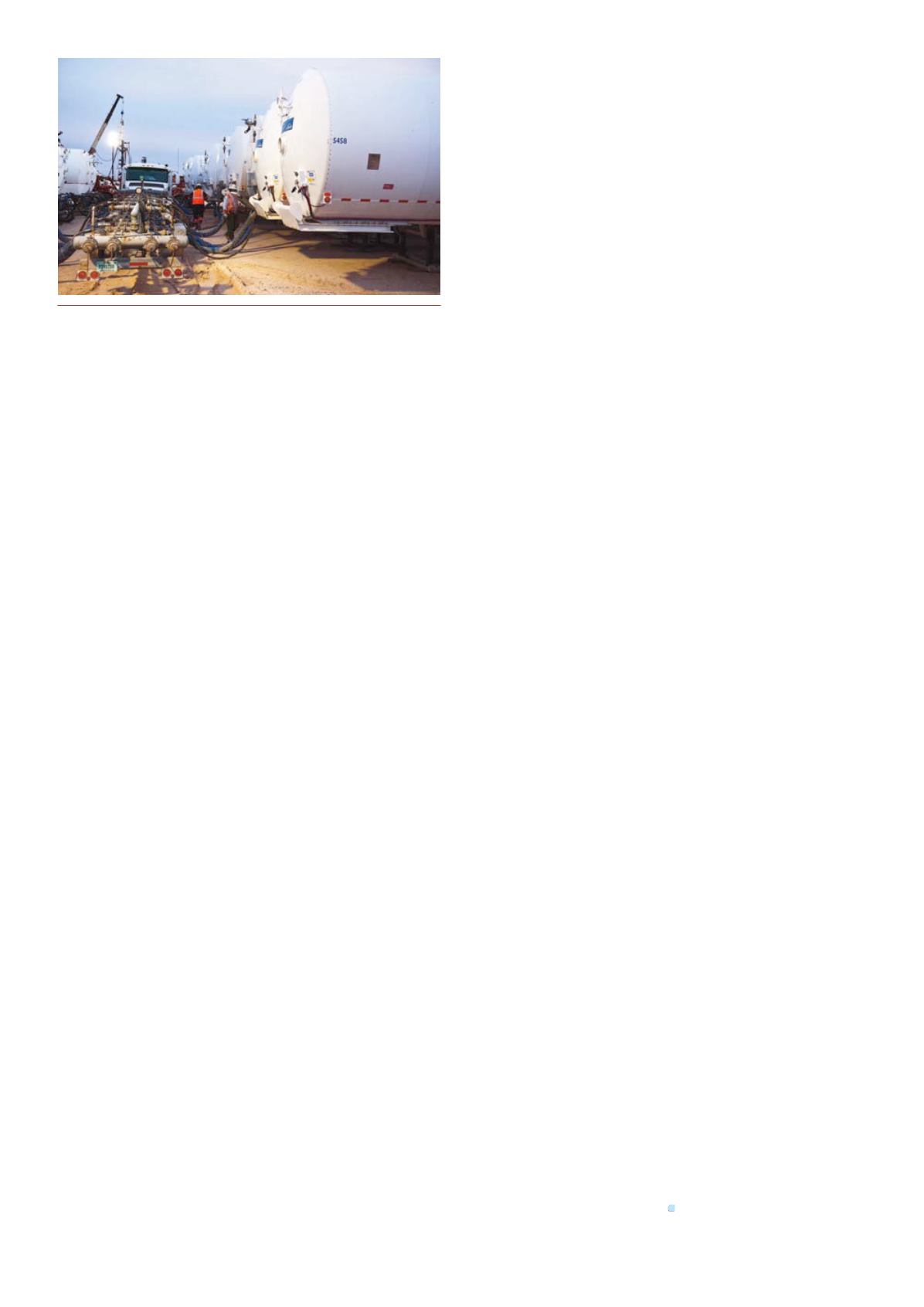
58 |
OilfieldTechnology
February
2014
channels intherock,whichcan increasetheextractionratesandultimate
recoveryofhydrocarbons.
Themorecommonfracturingfluidsusedtodayaregelledor
water‑based,andCO
2
andN
2
havebuiltareputationofbeingfluidsthatcan
reliablybeharnessedforthesuccessfulhydraulicfracturingandstimulation
ofwells.Recentstudies indicatethat, fromaneconomicperspective,
hydraulicfracturingwithsolutionsenergisedbyCO
2
orN
2
canachieve
significantlymorehydrocarbonrecoverythannon‑energisedapproaches.
Onesuchstudyfoundthatuseofenergisedfluids improvedwell
performancebyupto2.1times,comparedwithnon‑energisedsolutions.
Theultimategoalofwellstimulation istoachievemaximum
productivityatthe lowestunitcost,butachievingeconomicallydesirable
fracturepenetrationandconductivitycanbeparticularlychallenging in
unconventionalreservoirs.Fracturingwithfluidsthatarenotenergisedcan
leave liquidstrapped in low‑permeability,tight,depletedor
water‑sensitiveformations.Thisfluidremaining intheformation lowers
thefractureconductivity,reducingor impedingtheflowofoilandgas.Very
often inwater‑basedhydraulicfracturingfluids,themajorityofthewater
isneverrecoveredfromunconventionalreservoirsandthewaterthat is
recovered iscontaminated.
Proppantcanbe improperlydeposited,resulting inblockingor
impedingflowandherefoamedenergisedfracturingfluidsareproviding
superiorproppanttransportproperties.Gelledfracturingfluidsmustbe
flushedfromtheformationtocleanoutasmuchresidueaspossiblefrom
theproppantpack.
EnergisingthefracturingfluidwithCO
2
orN
2
also improvesthetotal
flowbackvolumeandrate,minimisesfluidretentionandreducesthe
requiredwatervolume,whichhassignificanteconomic implications.CO
2
actuallyvaporisesatreservoirconditions, leavinga liquid‑freeproppant
pack.
Avoidingdamage,definedas ‘any inducedreservoirchangethat inhibits
orrestrictshydrocarbonflowduringwellstimulation’, iscritical.There is
evidencethattheuseofthese industrialgasesalsoreducesthedamage
causedbyproppant, fracturesthataretoofarapartandresiduefrom
polymersandgels.
Theflexibilityofenergisedsolutionsallowsforthehydraulicfracturing
fluidtobemixedaccordingtothetechnologicalneedsofunconventional
reservoirs.Theyprovidemorerapidandcompletetreatmentfluidrecovery,
helptocleanwithouttheneedforswabbingandreduceformationdamage
byminimisingtheamountofaqueousfluids introducedtotheformation.
Energisedsolutionsalsooffertheabilitytohavesuperior
proppant‑transportpropertiesand, inthecaseofunderpressuredor
depletedzones,provideenhancedenergyforhydrocarbonrecovery.
Flexibility insolutionviscosityallowsforamoreuniformdeposition
ofproppants, improvingconductivityoftheproppedareatoenhancethe
Figure4.
When injected intowellsenergisedLINandCO
2
gassolutions
areabletoenhancehydrocarbonproductionratesandyields.
flowofhydrocarbons. Inunconventionalreservoirs,energisedsolutions
providethenecessary lifttomovehydrocarbons in lowpressurezonesor
areaswithstrongcapillaryforces.Thesolubilityandmiscibilityproperties
ofCO
2
providegreateropportunitytoenergisetheflowofmoreviscous
hydrocarbons.
Extractionandprocessing
Nitrogen (N
2
)andcarbondioxide (CO
2
)asbulkgasesareused in
hugequantities fortheextractionandexplorationofnaturalgaswith
inducedhydraulic fracturing.Thetraditionalprocess forpropagating
hydrocarbonstrapped inunderground fractureshadrequiredhigh
volumesofwater,mixedwith foamingagentsand frictionreducersand
injectedathighpressure intothe fractures,crackingopentheshaleand
creating fissuresallowinggasoroilcontainedwithinthemto flow freely.
Alternativetechniques,whichcanhelpmitigatewater‑related
issues in fracturing, includeemployingCO
2
mixedwithalcoholor liquid
nitrogen (LIN) inaprocessknownas ‘dry fracturing’.TheCO
2
/alcohol
mix isalso injectedathighpressureundergroundtoopenup fractures,
withtheCO
2
expandingas itvaporises,allowingnaturalgasto flowout
throughthecrackstobecollectedandprocessed.
Liquidnitrogen isusedfor ‘dryfracking’–afracturingprocessthat
haseliminatedmanyoftheproblemsassociatedwithhydrofracturing
andcouldprovetobemoreacceptabletopeopleconcernedabout
theenvironment. Itusesveryfew,ornochemicals,andafterfracturing
thenitrogen isreleased intotheatmosphere,whichalreadycomprises
78%nitrogen.Nitrogenhasbeenshowntoyieldhighereconomicvalue
incomparisontoconventionalchemical fracturing; it isbeingused
extensivelyfornaturalgasextraction inareasofhighenvironmental
sensitivity.
Replacingwater
Asthe industrycontinuesto focusonreducingtheamountofwater
required forhydraulic fracturinganddevelopingcompletiondesignsto
sustainwellproduction,greateremphasis isbeingplacedontheuseof
cryogenicgasesandassociated fieldsupportservicestoachievethese
goals.
LindeGasproducesN
2
andCO
2
in liquid format facilitiescloseto
hydraulic fracturingsitesanddeliversthesegasesontosite inroad
tankers.Withthousandsof tonnesof this liquidgasrequiredatany
onetime,delivery isoftenmadetoan intermediarysitewhere it is
stored in largecontainersaveragingacapacityof70t.Thecompany
managesthese logisticsandownsthedistributionequipmentrequired
toundertaketheconnectionstopumpsandassociatedmixtures.
Thisensuresthatthenecessaryexpertise isavailableandprovides
compliancewithsafetyregulations.Allwellsitesare inspectedandhave
adocumentedriskassessmentperformedbytrainedpersonnel.
Lastyear, thecompany introducednitrogenportablestorage
vessels (NPSVs) thatenablehydraulic fracturingoperatorsandservice
companiestoexpandtheirnitrogenstoragecapabilitieson location.
Providing16700gal.ofstoragecapacity,NPSVsaretransportable
cryogenicvesselsthatallowhighvolume liquidnitrogentobedelivered
directlytoproduction locations,minimisingtheneed forongoing
shuttlingofnitrogen fromstagingareastoproduction locations
andreducingthecostsanddelaysassociatedwith interruptions
from frequentdeliveries.Thisapproachalsominimisesoperational
complexitiesnearthewellhead.
NPSVsoffernumerousbenefits, includingasmaller footprintand
significantlyreduced labourandequipmentcostsassociatedwiththe
ongoingshuttlingofnitrogen fromthestagingareatothewellhead.
Unliketheconventional largercontainers,NPSVsdonotrequire
DepartmentofTransportationpermitsandallow formanoeuvringonthe
mostchallengingoff‑roadterrains.


